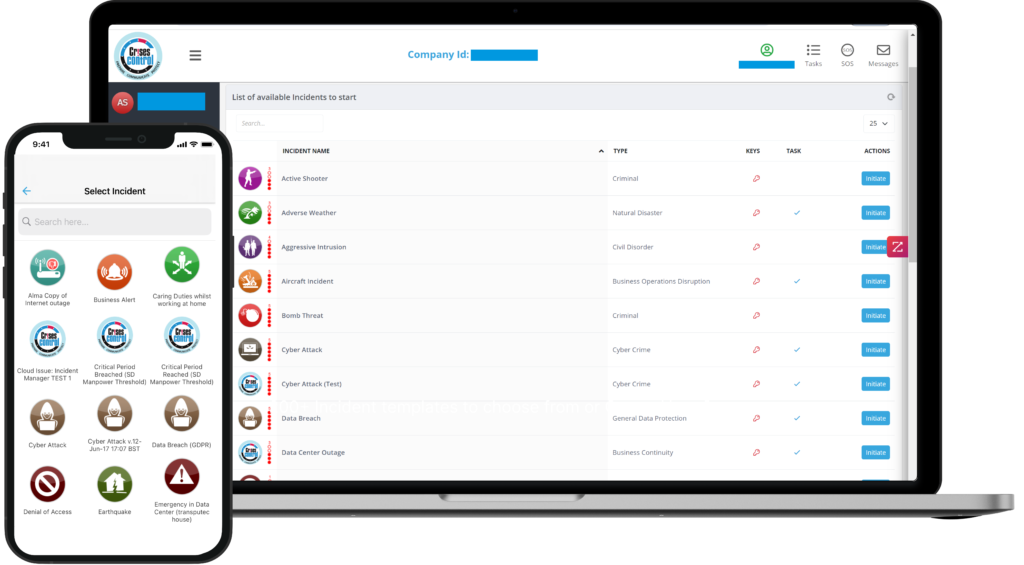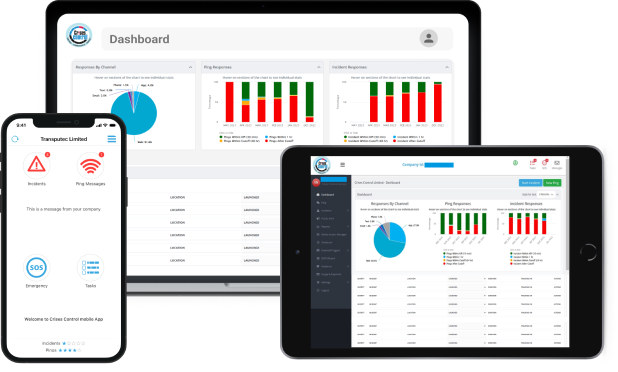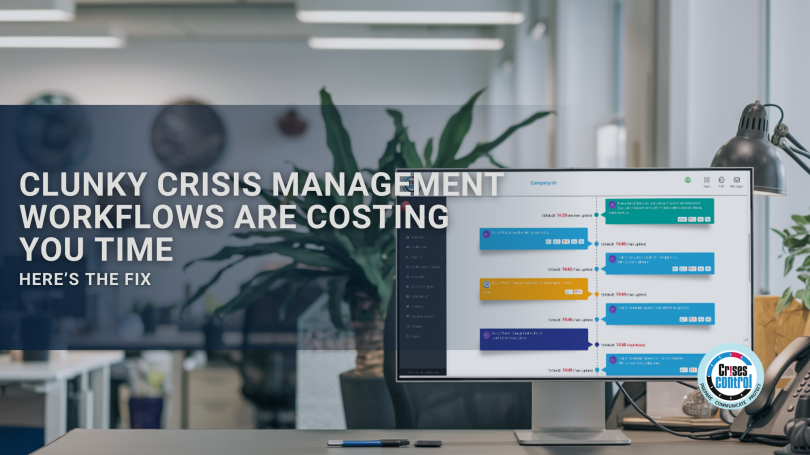Written by Anneri Fourie | Crises Control Executive
When a crisis hits, time is your most valuable asset. Every second spent on disorganised processes is a second wasted. Whether it’s a cyber attack, a supply chain issue, or severe weather, clunky crisis management workflows only add to the chaos. They slow down your team, make it harder to make quick decisions, and can escalate the impact of the incident.
In this blog, we’ll explore why outdated crisis workflows are costing your business and how adopting a modern crisis management platform can save you time, reduce mistakes, and get your team working together more effectively when it matters most.
Why Crisis Management Workflows Are Broken
Too many organisations still rely on fragmented systems to manage crises; spreadsheets, email chains, or messaging apps like WhatsApp. While these tools are useful in everyday situations, they fall apart under pressure. Here’s why:
Slow Decision-Making
In a crisis, the clock is ticking. The longer it takes to collect the right information and communicate it to the right people, the more damage is done. Traditional methods like email or phone calls create bottlenecks that make it harder to make fast decisions. When critical information is spread across multiple platforms, decisions are delayed, and opportunities are missed.
Communication Gaps
Without a centralised system for communication, it’s too easy for important updates to get lost in the shuffle. One department might not receive a message until it’s too late, or they might get conflicting instructions from different sources. In the chaos of a crisis, this can cause confusion, missed steps, and even prevent the response team from coordinating effectively.
Lack of Real-Time Visibility
When your teams are working across different systems, it’s difficult for decision-makers to have a clear picture of the situation. You need to know who’s doing what, when, and where, but with traditional tools, this information is often missing or outdated. When visibility is low, your response becomes reactive instead of proactive, making it harder to stop the crisis before it escalates.
Compliance Issues
In an emergency, every action should be tracked for both accountability and legal reasons. If your systems don’t provide clear records of what happened and why, you could be exposed to regulatory scrutiny. Manual systems make it almost impossible to track and report everything accurately, leaving you vulnerable.
These challenges are more than just inconvenient, they’re costly. Every minute lost to a slow response or miscommunication is a minute that compounds the damage to your business, brand, and bottom line.
The Hidden Cost of Clunky Workflows
The cost of poor crisis management goes far beyond the immediate effects of the incident. When workflows aren’t streamlined, recovery time increases, and that means higher costs—both direct and indirect. Lost productivity, operational disruption, customer trust, and potential legal fees all add up.
In fact, research from the Business Continuity Institute shows that organisations with structured crisis management processes recover 40% faster than those without. If your business can’t recover quickly, it not only loses money but also risks its reputation.
Many enterprises assume their size or existing processes will be enough to get through any crisis. But when the unexpected happens, it quickly becomes clear that outdated methods and disconnected systems aren’t enough to cope. That’s why it’s essential to adopt a more streamlined, integrated approach to crisis management.
How to Improve Crisis Response Workflows
The solution isn’t about replacing your team with machines. It’s about giving your team the right tools to respond quickly and effectively under pressure. Here’s what a well-designed crisis management system should look like:
1. Centralised Command
Your crisis response needs to be managed from one place, where everything from incident alerts to task tracking happens in real time. This keeps all your teams aligned and ensures there’s one source of truth, reducing confusion and helping everyone move in the same direction.
2. Multi-Channel Communication
Effective communication during a crisis isn’t just about sending an email and hoping everyone sees it. You need crisis communication software that delivers messages via multiple channels, SMS, email, phone calls, and push notifications, all at once. This ensures you can reach everyone, even if one communication channel goes down.
3. Real-Time Updates
In a crisis, you can’t afford to make decisions based on outdated information. Decision-makers need a clear view of what’s happening on the ground right now. A dashboard that provides real-time visibility into the situation allows for faster, smarter decisions, so you’re not left in the dark.
4. Pre-Built Response Plans
A good crisis management platform allows you to set up workflows in advance for different scenarios. These workflows can be tailored to specific types of incidents, so when something does go wrong, your response is already mapped out. This isn’t about reacting in the heat of the moment, it’s about having a plan ready to go as soon as you need it.
5. Automated Escalations and Tracking
When things don’t go according to plan, your system should escalate issues automatically, alerting the appropriate people so nothing falls through the cracks. Having an audit trail ensures that every decision, action, and communication is documented, making post-crisis analysis much easier and more reliable.
These are the elements of a modern crisis management system, and they’re achievable today. You just need the right tools.

Interested in our Incident Management Software?
Customise your Crisis Incident Management Software to meet your specific needs with our flexible tools & stay connected and informed during the crisis and incident management process
The Benefits of Modern Crisis Management Platforms
Switching to an integrated, cloud-based crisis management platform like Crises Control can completely transform how your team handles crises. Here’s how:
Faster Response Time
With everything in one place, you can cut down the time it takes to assess a crisis and take action. Automated workflows help teams move faster, without needing to waste time coordinating across different tools.
Confidence Under Pressure
When teams have clear instructions and the right information at their fingertips, they can act with confidence, even in high-pressure situations. Guided playbooks and real-time updates mean your team will know exactly what to do next, reducing confusion and mistakes.
Global Reach
Whether your team is in London, New York, or Sydney, you can reach them instantly. Modern platforms ensure that your crisis communication can span time zones, languages, and borders, giving you a truly global response capability.
Operational Resilience
Crises Control helps protect your operations, reduce downtime, and maintain business continuity. The result? You’ll experience fewer disruptions and less revenue loss, no matter what kind of crisis you face.
Transparency and Accountability
With every action tracked in real time, you’ll have full visibility into how your crisis response is progressing. This makes it easier to analyse your response afterwards and helps you demonstrate accountability when required.
In short, a modern crisis management platform doesn’t just help you manage crises, it helps you recover more quickly, act more confidently, and protect your business better.
Why Choose Crises Control?
Crises Control isn’t just another piece of software. It’s a tool that empowers your team to respond to crises with speed, coordination, and precision.
Here’s how Crises Control stands out from the crowd:
- End-to-End Incident Management:Once a crisis hits, Crises Control enables you to manage the entire response process—from activation and communication to resolution—all in one platform.
- Multi-Channel Communication: Ensure that your messages are delivered instantly, no matter what communication channel your teams rely on.
- Customisable Playbooks: Design workflows for every possible crisis scenario, from cyberattacks to natural disasters.
- Real-Time Analytics: Monitor your crisis response in real time and adjust your strategy as the situation evolves.
- Compliance Ready: Built with standards like GDPR and ISO 22301 in mind, Crises Control ensures you stay compliant during and after a crisis.
Interested in our Ping Mass Notification Platform?
Efficiently alert everyone in seconds at scale with our Mass Notification Platform – PING, get the message out fast and ensure rapid response and recovery.

Use Case: A Real-World Example
A leading healthcare provider in Abu Dhabi, UAE, faced significant challenges during crises due to their reliance on traditional communication methods like email and manual call trees. These methods were time-consuming and prone to delays, making it difficult to quickly notify the right people during critical situations. As a result, their ability to respond efficiently to emergencies and ensure continuous patient care was compromised.
By implementing Crises Control, the hospital was able to streamline its communication and incident management processes. Here’s how the hospital benefitted:
- Faster Notifications: Crises Control enabled the hospital to instantly notify key personnel with a single click, eliminating delays associated with manual call trees and emails.
- Improved Response Times: With real-time communication, the hospital’s teams were able to act swiftly, improving their overall response times during emergencies.
- Efficient Incident Management: The platform allowed the hospital to group personnel into specific tiers for more targeted notifications, ensuring that the right people received the right information at the right time.
- Seamless Integration: The platform was seamlessly integrated into daily operations, allowing the hospital to maintain focus on patient care, even during disruptions.
As a result, Crises Control empowered the hospital to improve its crisis management capabilities, reducing response time, enhancing communication, and ensuring the hospital could continue delivering exceptional care during emergencies.
Read the Full Case Study
Conclusion: Don’t Wait for the Next Crisis
The question is not if, but when, your organisation will face a crisis. And when that happens, will your existing workflows be able to keep up, or will they slow you down?
A modern crisis management platform like Crises Control can help you respond faster, act with confidence, and minimise disruption to your business. It’s time to move past outdated methods and embrace a smarter way to manage crises.
Book a free demo today and see how Crises Control can help transform your crisis response.
Request a FREE Demo

